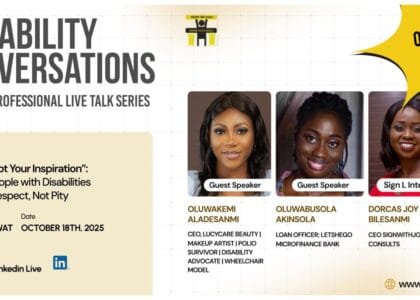Representation in the media is powerful. It shapes how people are seen and how they see themselves. But when it comes to disability, especially autism, the question is not just if there is representation, but how it is being done. That’s what we explored in the July edition of Dis-Ability Conversations with our guest speaker, Mr. Remi Olutimayin.
This conversation was deeply personal. Mr. Remi is not only a seasoned voice director and storyteller. He is also an autistic adult. His lived experience made this session both insightful and honest as we focused on the way people on the spectrum are represented on screen.
Let’s Be Honest. Are We Getting It Right?
We’re seeing more characters with autism in movies and shows today. But what often happens is that they are either painted as savants or portrayed in overly simplified ways. Mr. Remi pointed to popular shows like:
- The Good Doctor, where the main character is a genius sur/eon on the autism spectrum. While the show brings visibility, it also feeds into the idea that value only comes from being exceptional.
- Extraordinary Attorney Woo, where the character is an autistic lawyer navigating the legal world. It gives us a more rounded view, but the story still revolves around her brilliance, not her everyday humanity.
Mr. Remi reminded us that real life isn’t always dramatic or genius-level. It’s in the ordinary, the messy, the quiet, and the learning. People with autism deserve to be seen as whole people, not only when they perform or exceed expectations.
“We’re Not Metaphors or Plot Devices”
One of the most important takeaways from Mr. Remi’s message was this: People with disabilities are not here to serve as emotional triggers for other characters. They are not symbols. They are not life lessons in disguise. They are people, with voices, dreams, and stories of their own.
He also challenged writers and media professionals to stop writing about autistic characters without involving autistic people in the process. If you’re not listening to the people you’re portraying, the story risks becoming shallow, even harmful.
Beyond Representation, what’s Next?
Representation is a start, but it’s not the finish line. Real inclusion in media means:
- Telling stories that show the full human experience of people on the spectrum
- Hiring autistic creatives to be part of storytelling teams
- Being mindful of the expectations media sets about what it means to live with a disability
When you keep expecting people with autism to be exceptional, you miss out on understanding who they really are. Everyone deserves to be see, not just when they’re achieving something impressive, but when they’re just being themselves.
If you missed this powerful session, you can catch the replay. But more importantly, take this as an invitation to think deeper about what we watch and who is included in those stories. True representation doesn’t glorify or pity. It sees.
Hamdallah Dolapo,
For,
Dis-Ability Conversations Team,
KTC-KYC Educational Consult & Academy Ltd.

